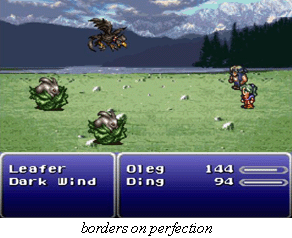(Please note: Although this game was published in the United States as Final Fantasy III for Super Nintendo, it is more commonly [and more accurately] known as Final Fantasy VI.)
Let’s take a step back from 3D realms, polygons per second, and anti-aliasing. Back in the 16-bit days, there lived a creature called a sprite. They were little creatures who could do fantastic things, in a relatively simple world. If these sprites had a religion, their heaven would be Final Fantasy III.
Fans of the Final Fantasy series that began with VII may be initially turned off by this game. Going back to sprite-based characters from the 3D world may be too big of a leap for them. To all of them I say, “You have no idea what you are missing.” Diehard fans of the series often vote this as the best Final Fantasy for its great story, music, and (at the time) graphics. It’s true, Final Fantasy III is a great game, and borders on perfection. The key word there is “borders,” for those of you who failed English 101. That means this game does have flaws, but nothing so bad that ruins the experience.
The game plays much like any other RPG of its time. The first character in your party is seen on screen through a three-quarters perspective on the field map and in towns. Here you interact with townsfolk, shop for items, or navigate dungeons. Of course, in the field you will run into the infamous random encounters. It usually works out so that the enemies are on the left, and your party is lined  up on the right. There is the chance of being ambushed or pincer attacked, though, so watch out. Controls work just fine—nothing too serious in this game.
up on the right. There is the chance of being ambushed or pincer attacked, though, so watch out. Controls work just fine—nothing too serious in this game.
You start the game as Terra, a woman with the power to use magic. After the War of the Magi 1000 years ago, magic was thought to be entirely extinct. Now, people fear magic and its destructive powers, and rely on science to help them in their every day lives.
The Empire, led by Emperor Gestahl and his manic general Kefka (who has the most characteristic laugh in videogame history), seeks to revive magic and rule the world. Their efforts to combine science and magic result in some pretty powerful MagiTek armor suits. A group of rebels, who call themselves the “Returners,” endeavor to stop the Empire and keep the world peaceful. Final Fantasy III takes you on a journey across continents, through the end of the world, and on a quest to dethrone Kefka from his godlike tower.
The graphics in the game are done beautifully for the time. The characters look great, and the enemies you face off against are drawn very well. The game’s graphics really shine for spell effects and the summoning of Espers, the game’s powerful magical beings. The higher-level spells and Espers gave SNES players a treat back in the 16-bit era. Visuals aside, the sound and music in the game are amazing as well. The music sucks you into the game, and doesn’t let go until the credits stop rolling. Riveting battle music, a memorable opera scene, and the inspiring character themes will keep your ears perked up.
Yes, the game does have downsides, one of which is character development. For an RPG, FFIII has a fairly large cast of playable characters. While not as large as Chrono Cross‘s (which is obscene), Final Fantasy maxes out at fourteen. Out of these fourteen, the player can only really connect with about five or six. The others are just simply “there” if you decide to mix up your party at some point. That’s a major point that Square has now fixed with later Final Fantasies.
Have no fear; character development is the only real problem in this game. It is by far one of the best games for the SNES, and ranks among the best Final Fantasy games ever. Own a SNES? Buy this game, somehow, somewhere, for any price. Don’t own a SNES? Emulators are better than nothing, I guess.
Get this game!
